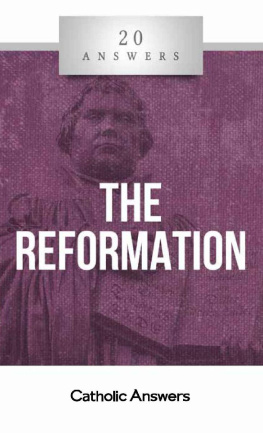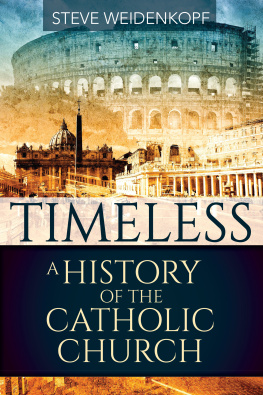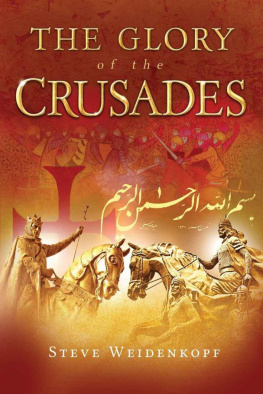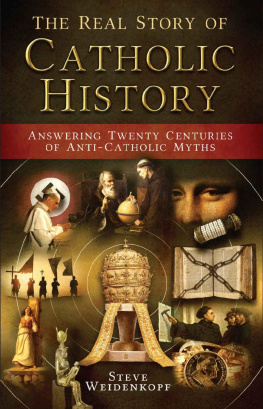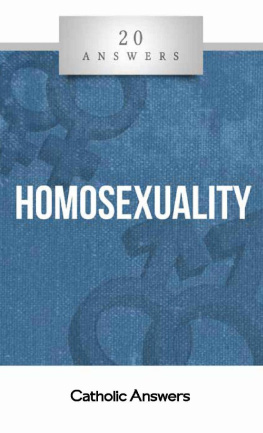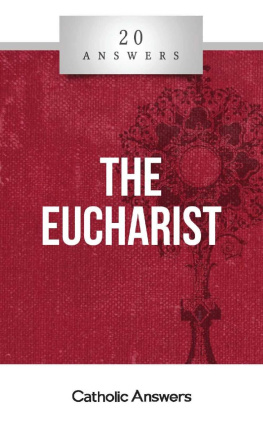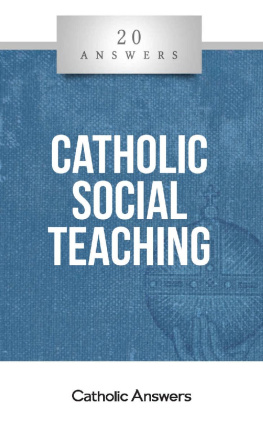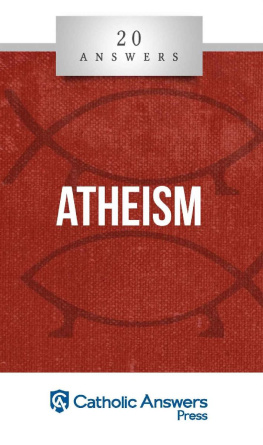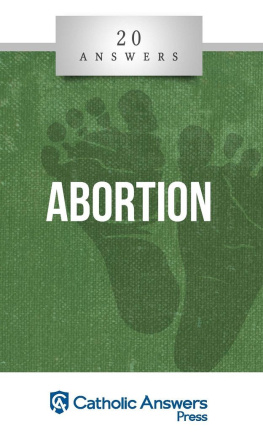Steve Weidenkopf - 20 Answers- The Reformation (20 Answers Series from Catholic Answers Book 26)
Here you can read online Steve Weidenkopf - 20 Answers- The Reformation (20 Answers Series from Catholic Answers Book 26) full text of the book (entire story) in english for free. Download pdf and epub, get meaning, cover and reviews about this ebook. year: 2018, publisher: Catholic Answers Press, genre: Religion. Description of the work, (preface) as well as reviews are available. Best literature library LitArk.com created for fans of good reading and offers a wide selection of genres:
Romance novel
Science fiction
Adventure
Detective
Science
History
Home and family
Prose
Art
Politics
Computer
Non-fiction
Religion
Business
Children
Humor
Choose a favorite category and find really read worthwhile books. Enjoy immersion in the world of imagination, feel the emotions of the characters or learn something new for yourself, make an fascinating discovery.
- Book:20 Answers- The Reformation (20 Answers Series from Catholic Answers Book 26)
- Author:
- Publisher:Catholic Answers Press
- Genre:
- Year:2018
- Rating:5 / 5
- Favourites:Add to favourites
- Your mark:
- 100
- 1
- 2
- 3
- 4
- 5
20 Answers- The Reformation (20 Answers Series from Catholic Answers Book 26): summary, description and annotation
We offer to read an annotation, description, summary or preface (depends on what the author of the book "20 Answers- The Reformation (20 Answers Series from Catholic Answers Book 26)" wrote himself). If you haven't found the necessary information about the book — write in the comments, we will try to find it.
20 Answers- The Reformation (20 Answers Series from Catholic Answers Book 26) — read online for free the complete book (whole text) full work
Below is the text of the book, divided by pages. System saving the place of the last page read, allows you to conveniently read the book "20 Answers- The Reformation (20 Answers Series from Catholic Answers Book 26)" online for free, without having to search again every time where you left off. Put a bookmark, and you can go to the page where you finished reading at any time.
Font size:
Interval:
Bookmark:
20 Answers
The Reformation
Steve Weidenkopf

20 Answers: The Reformation
Steve Weidenkopf
2017 Catholic Answers
All rights reserved. Except for quotations, no part of this book may be reproduced or transmitted in any form or by any means, electronic or mechanical, including photocopying, recording, uploading to the internet, or by any information storage and retrieval system, without written permission from the publisher.
Published by Catholic Answers, Inc.
2020 Gillespie Way
El Cajon, California 92020
1-888-291-8000 orders
619-387-0042 fax
catholic.com
Printed in the United States of America
978-1-68357-066-0
978-1-68357-067-7 Kindle
978-1-68357-068-4 ePub
Table of Contents
Men must be changed by religion, not religion by men.
Giles of Viterbo, 1512
Introduction
Holy Roman Emperor Charles V (15001558) was annoyed and tired. His southern borders were under attack by the Ottoman Turks, and for the last twelve years his lands had been engulfed in religious disputation and even violence brought about by the writings and teachings of the Saxon monk Martin Luther (14801546). Eight years previously, the emperor had issued a condemnation of Martin Luther and his teachings and declared him an outlaw. Luther had gone into hiding and had been on the run from imperial authorities ever since.
Charles V called for the imperial Dietan assembly of German princes and representatives of imperial townsto meet in the town of Speyer in 1529 to discuss Luthers endeavors. He hoped the meeting would end the religious bickering. But many German rulers and territories had embraced Luthers revolt and were now persecuting the Catholic Church. The holy sacrifice of the Mass had been banned in various areas throughout the empire. This infuriated Charles. He issued an edict at the meeting in Speyer demanding unhindered celebration of the Mass. However, some nobles and the representatives of fourteen cities and towns, which had embraced Lutheranism, protested the emperors decree and boldly declared that the Mass would not be celebrated in their areas. This action provided the movement with the name it has been identified with ever since: Protestant.
The Protestant Reformation was one of the defining moments in Christian history. It shattered visible Christian unity and has helped shape the last 500 years of Western civilization. It is a historical event with wide popular recognition but little true understanding.
Modern-day Protestants and Catholics alike are hard pressed to accurately tell the story of this momentous revolution. Myths, misunderstandings, and much propaganda exist about the characters involved, the theology discussed, and the historical events themselves. This booklet provides the reader with a brief overview of the persons, doctrines, and actions of a movement that cleaved Christendom and spawned centuries of acrimony and violence among the followers of Christ.
1. What was the Reformation?
The Protestant Reformation was a religious and political revolution that swept through Christendom in the sixteenth and seventeenth centuries. The initial event is usually identified as the publication of Martin Luthers Ninety-Five Theses on October 31, 1517, in the city of Wittenberg in modern-day Germany (at the time Electoral Saxony). It is difficult to date the end of the Reformation. An argument can be made that it is ongoing, but the end of the Thirty Years War in 1648 is a good marker, since by that time, Protestantism was firmly entrenched in the political and cultural life of Europe.
Although it is commonly known as the Reformation, the movement was not an authentic reform of the Catholic Church, but rather a revolution against what the Church believes, what it teaches, and how it worships. The early Protestant revolutionaries, such as Martin Luther and John Calvin, sought to replace the Catholic Church with what they believed was a return to a pristine manifestation of the Christian faith. A reformation operates from within, to correct abuses, to make an organization better, and to restore good habits. A revolution seeks to replace an organization with something new.
The Protestant Reformation focused on a rejection of Church (specifically papal) authority and the destruction of the entire sacerdotal and sacramental system. The movement was marked by two phases: internal and external.
Initially, the Protestant movement was an internal event marked by intense religious discussions within Christendom. People expected that the disagreements would be settled and that life would continue as before. However, the religious discussions soon intertwined with political considerations, and what began as an internal movement took on larger implications. Secular rulers saw the movement as an opportunity to strengthen their authority against the Church and as a means to appropriate Church wealth. Externally, the movement developed a new and separate culture, form of worship, and way of life. The unity of the Church was shattered, and the concept of Christendom was cleaved.
Heresy produces violence, which is why it was considered both an ecclesiastical and secular crime in the sixteenth century. As with earlier heresies, violence followed the religious discussions resulting from the Reformation so that what began as a sort of spiritual family quarrel and continued as a spiritual civil war was soon accompanied by an actual civil war in arms. Europe was engulfed in violence for a century as a result of the Reformation, and the modern world continues to suffer from the teachings that took root in the minds of men during the sixteenth century.
2. What were the factors that led to the Reformation?
The chief factors that contributed to the Protestant Reformation were the status of the papacy, secular concerns, and abuses within the Church.
The seeds of the Protestant Reformation are found in the fourteenth century, when the papacy, instituted by Christ to be a source of unity, lost prestige and respect in Christian society through a series of events.
First, Pope Clement V (r. 13051314), manipulated by the French king Philip IV, the Fair (r. 12851314), moved the papal residence from Rome to Avignon. The popes resided in the southern French city for seventy years. Their absence from Rome produced chaos and scandal throughout the Church.
Primarily through the efforts of St. Catherine of Siena (13471380), the pope returned to Rome, but soon after, the Great Western Schism (13781417) erupted, where multiple antipopes laid claim to the Chair of St. Peter. As a result, the papacy was not positioned strongly to deal with the revolution brewing in Germany in the early sixteenth century.
Resentment against the papacy grew in areas without strong central governing authority, and areas with strong rulers fell sway to nationalism. Secular rulers viewed themselves independently of the papacy and, in some cases, tried to control the Church in their territory.
Much of the discontentment with the Church in Europe also involved money. The Churchs prohibition against usury and commerce on Sunday was an irritant to the merchant class. Secular rulers were envious of Church lands and wealth, and the continent-wide flow of funds to the Roman curia contributed to a growing bitterness against the authority of the papacy.
By the sixteenth century, there were also numerous ecclesiastical abuses infecting the Church. Most of these abuses were not new and had been dealt with previously, but lax leadership, especially among the popes, allowed for these issues to reappear.
Simony, or the buying and selling of Church offices, traces its origin to apostolic times, when a former magician named Simon witnessed the conferring of the Holy Spirit by the apostles through the laying on of hands. Simon offered the apostles money in exchange for the authority and power to confer the Holy Spirit as well but was rebuked by Peter. Simony has plagued the Church at various times throughout its history and was an issue at the time of the Reformation, too.
Next pageFont size:
Interval:
Bookmark:
Similar books «20 Answers- The Reformation (20 Answers Series from Catholic Answers Book 26)»
Look at similar books to 20 Answers- The Reformation (20 Answers Series from Catholic Answers Book 26). We have selected literature similar in name and meaning in the hope of providing readers with more options to find new, interesting, not yet read works.
Discussion, reviews of the book 20 Answers- The Reformation (20 Answers Series from Catholic Answers Book 26) and just readers' own opinions. Leave your comments, write what you think about the work, its meaning or the main characters. Specify what exactly you liked and what you didn't like, and why you think so.

